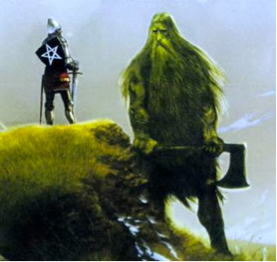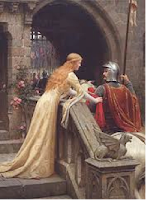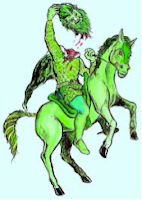Warning: Spoilers
Sir Gawain and the Green Knight
was not the medieval romance I expected. I was expecting damsels in distress and
knights in shining armor. Instead, the majority
of the poem was Sir Gawain trying to fend off the advances of a married woman, and
winning kisses along the way. During
these scenes, he not only lacked shining armor but clothing in general, and
Lady Bertilak was certainly not a damsel, much less a damsel in distress.
The poem continued to reverse my expectations by presenting me with a less-than-perfect hero. Sir Gawain is obsessed with chivalry, so much so that he paints a symbol that represents the five qualities of a knight on his shield, but he nonetheless manages to fail in all of these five qualities by the end of the poem. These five aspects of chivalry are all presented in both positive and negative lights throughout the poem.
The parts of the poem that did not focus on
flirting focused on “The Beheading Game”.
In this game, Sir Gawain cuts off the Green Knight’s head and the miraculously
not-dead-yet Green Knight is supposed to return the favor. He is told to come to the Green Chapel one
year from the beheading to get his own head chopped off, and is honor-bound to
do so.
Supposedly, Sir Gawain’s flaw are presented in the end when he keeps a magical green girdle (ribbon) that will protect him from harm despite an agreement he had to give everything he won to his host, Lord Bertilak.
Another failing is that Sir Gawain flinched as the Green Knight swung his ax to behead him. However, the fact that Sir Gawain didn’t realize that The Beheading Game was a bad idea in the first place may show that his real flaw was stupidity rather than any failure of virtue. I guess you’ll have to read on and decide for yourself.
In
its portrayal of chivalry, Sir Gawain and
the Green Knight is “both a tribute to romance and a critique of it”, and the poet uses chivalry to “reveal fascinating paradoxes in the romance world.” In the subsequent blog series, I will take a
look at each of these knightly qualities – generosity, friendship, chastity,
courtesy, and piety – in turn, analyze how they present chivalry in both a
positive and negative light, and then compare Sir Gawain and the Green Knight to modern medieval fantasies.




No comments:
Post a Comment